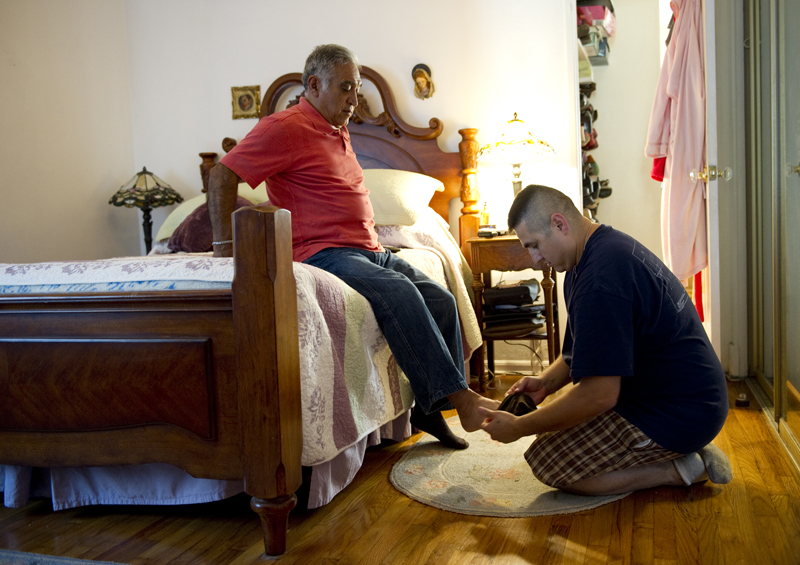AARP Hearing Center

Column by Marissa Volpe -
Cristina is a 48-year-old caregiver to her 82-year-old mother in Denver, Colo. She works full time as a custodian, is raising three children as a single mother and in the afternoons, after her early morning work shift ends, she takes classes to become a Certified Nursing Assistant. Caring full time for her mother, who is paralyzed and living with Alzheimer’s disease, is around the clock work. She relies on the help of her children. Dolores, her youngest daughter, pitches in feeding her grandmother or taking her outside in her wheelchair to get fresh air and sunshine. Dolores, 15, is a high school student, attending a Jesuit high school on a full scholarship.
For this Latino family, their approach to elder care is intergenerational and family based. Beyond the cost for care, which may not be available to low-income families, the concept of familism or familismo carries weight in the Latino culture much as it does in African American, Asian, Middle Eastern and Native cultures. The emphasis on maintaining care within the family stems from cultural-religious values that suggest one's identity is formed through the love and care of others, particularly family members.
And yet, caring full time for a loved one with Alzheimer's disease can be an enormous task and one that families who are required to work full time are finding harder and harder to manage. Maria, a former caregiver, said it was only through attending classes at the Alzheimer's Association that she realized it was unsafe to leave her mother home unattended. "She would leave the gas stove on and could have potentially set the house on fire. When we finally moved her into an assisted living, we all felt better; I only wish we had made that decision sooner for her health and for ours."
The discussion of caring for an elderly parent conjures up visceral reactions. Certainly connecting children and grandchildren with care for their elders is vital for a society that has grown bereft for connectivity. This act of caring is good for children too, as it gives them a chance to learn to love their elders. Studies show that if a child watches his or her parent care for an elder, the child will become more likely to provide similar care for their parent in the future when the time comes. These values, espoused in almost every major religion, teach us that loving and caring for elders is a spiritual act.
Stretched to the limit of caring, however, caregivers can get burnt out. There may be gaps, like in the case of Maria and her mother, where family members are left home alone which may prove unsafe. And as more and more families of all ilks live lengthy distances apart from each other, day-to-day care becomes nearly impossible.
"Transnational Motherhood" was a term coined several decades ago to describe mothers who migrated to the United States to find work in the hopes of sending money home to their children living in their countries of origin. Is a similar pattern emerging for immigrants caring for elder parents?
In one such case, the children of Chinese-American immigrants live in the tech centric city of Louisville, Colo. These upper-middle class families have sponsored their aging parents in their move to the United States -- most are living in elder apartments in downtown Denver. There, the elders socialize with similar families and maintain traditions within the apartment complex. The children are busy with their careers and families but visit on occasion. The children provide some financial safety net for their parents, but may not know the day-to-day concerns of their parents' worsening health conditions. This hybrid model, which tethers families closer together and offers some cultural buffers such as in-group apartment living is another example at what care may look like in a diverse setting.
For Asian-American women, this changing model of elder care may provide a positive change for their health and well-being. According to the Department of Health and Human Services, Asian-American women have the highest suicide rates, especially over 65. Much of the depression is linked to overwhelming demands on women, who are expected to be dutiful and obedient daughters and daughters-in-laws who will unquestionably provide full-time care for elders.
What then can happen as cultures and care collide? What does a culture of care look like anyway?
What may be gleaned from high context, family based and traditional cultures is the importance of respecting elders, maintaining connectivity to future generations and to customs. Providing full-time care may not be the most ideal proposition, however; especially when it comes at the cost of one's personal health and well-being. And herein lies the rub.
Caring is both a virtue and a practical need -- we need to honor both of those realities. For some, caring provides an identity and a connection to key cultural, religious and social values. And yet when expectations about caring become burdensome, a boundary may be crossed. Also, when caregiving negatively impacts the caregiver, models emphasizing help for the caregiver, respite and reprieve are useful.
What I suggest is not hammering each culture with what is best for the other but rather healthy exchanges operating from strengths based approach. Latin and Asian cultures certainly can teach Anglo communities about the importance of connecting with elders and maintaining culture. The Anglo community can offer insight into how best to care for oneself so to be an effective caregiver. When each culture learns how the primary motivation in caring for elders, the result is certainly a fruitful conversation about caring for our loved ones and ourselves.
To learn about programs and services underway at the Colorado Chapter, please visit us at: www.alz.org/co
Marissa Volpe works in diversity and outreach at Colorado Chapter of the Alzheimer's Association.
[Photo courtesy of Alzheimer's Association/Barbara Kinney]































































